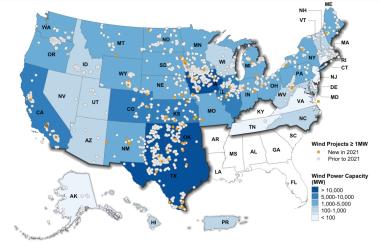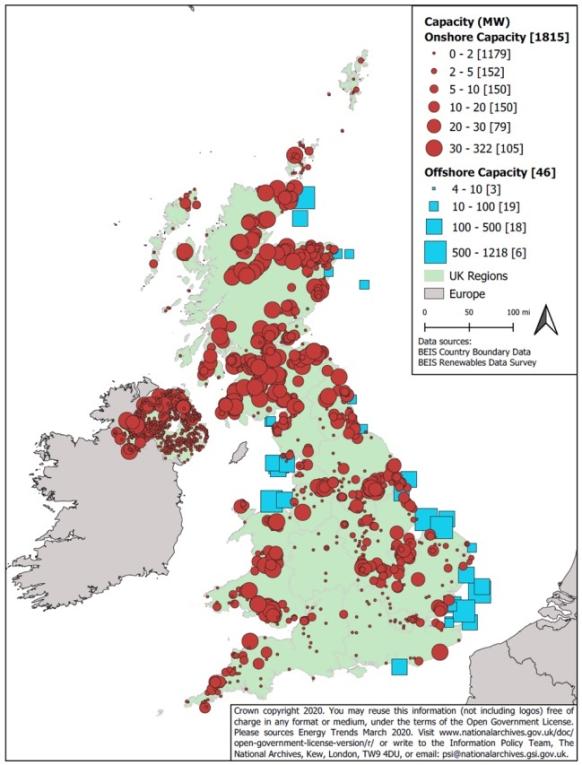US to cut federal land rates for renewable energy; UK opposition party pledges to unlock onshore wind
The wind power news you need to know.

Related Articles
US federal bureau lowers land costs for wind, solar
The U.S. Bureau of Land Management (BLM) plans to further reduce the fees for wind and solar on federal land and streamline permitting processes in priority areas under new proposed rules announced by the Interior Department on June 15.
The Biden administration aims to permit 25 GW of renewable energy on federal lands by 2025 and by March 2023 it had approved 8.2 GW of projects, mostly solar, data from the BLM shows.
In 2022, the BLM reduced acreage rents by 50% through guidance and the proposed rule will codify a reduction of 80%. The previous payment terms had deterred many developers as they led to higher project costs than on farmland and other locations. Federal land sites are also often less flat and wilder, increasing project costs.
The bureau will also start to accept non-competitive wind and solar leasing applications in priority areas when they are “in the public interest” and will continue to hold auctions “where appropriate and consistent with past practice,” it said.
The 245 million acres of U.S. public land managed by the BLM represent around 10% of the country's entire land area but host just 1% of national installed wind capacity and 6% of solar, according to data in 2022. Much of the land lies in 12 western states and the Rockies.
U.S. installed wind capacity in 2021
(Click image to enlarge)
Source: Department of Energy's 'Land-based Land-Based Wind Market Report,' August 2022.
The BLM is currently processing 74 utility-scale onshore clean energy projects for public lands in the western U.S., including wind, solar and geothermal projects, for a total capacity of 37 GW, the Interior Department said.
The bureau is reviewing a further 150 applications for wind and solar development, as well as 51 applications for wind and solar testing.
US Treasury clarifies key inflation act provisions
The U.S. Treasury Department and the Internal Revenue Service have issued new guidance on direct pay and transferability provisions for the clean energy tax credits allocated through the Inflation Reduction Act.
The inflation act offers a 30% investment tax credit (ITC) or a production tax credit of $27.5/MWh if labor conditions are met, plus an additional bonus of 10% if the project meets domestic content thresholds. The incentives aim to accelerate renewable energy deployment and expand domestic manufacturing capacity.
The latest clarifications, issued on June 14, set out conditions for elective pay and transferability, two provisions that allow local and state governments, as well as some for-profit entities, to benefit from the tax credits.
Treasury clarified that tax-exempt organizations “can receive elective payments for 12 clean energy tax credits, including the major investment and production tax credits.” This tool effectively allows public utilities to receive tax credits from the inflation act if they choose to develop their own renewable energy projects. In addition, private investors can claim elective pay for three of those credits: the credits for advanced manufacturing, carbon sequestration, and clean hydrogen.
Under the transferability provision, renewable energy developers can transfer all or part of their tax incentives to another party in exchange for cash. This allows developers with a small tax burden to monetize tax credits and access a wider pool of investment options.
“Making renewable tax credits broadly transferable helps address current constraints in the nation’s tax equity market, while the new direct pay regime makes it easier for tribes, state and local governments, co-ops and other nonprofit entities to participate in the clean energy transition,” the American Council on Renewable Energy (ACORE) said in a statement.
UK opposition Labour Party pledges to accelerate onshore wind
Britain's main opposition Labour Party would overturn a ban on onshore wind farms and require councils to identify areas for development if it wins a general election expected next year, the party said on June 19.
Opinion polls suggest Labour is on course to win the next election and the party has set a hugely ambitious target to decarbonise the entire power sector by 2030, five years earlier than the ruling Conservative party.
Labour plans to stop allocating new North Sea oil and gas licences following the election and plans to offer incentives to renewable energy that match the Biden administration's U.S. Inflation Reduction Act and counter pledges by the European Union.
The current UK government is yet to commit to equivalent plans, despite calls from industry.
The UK is leading Europe in offshore wind deployment and has built up significant supply networks in Scotland and in eastern and northern England.
UK onshore, offshore wind capacity in 2020
(Click image to enlarge)
Source: UK Department for Business, Energy and Industrial Strategy (BEIS)
Labour would create a state-owned renewable energy company called Great British Energy (GB Energy), based in Scotland, which would invest in projects alongside private investors, party leader Kier Starmer said in a speech on June 19.
GB Energy would primarily invest in cutting-edge technologies to reduce investor risk but would also be able to invest in more established technologies if it boosts private sector activity.
The UK operates 15 GW of onshore wind capacity and development activity has mainly been confined to Scotland since planning rules in England were toughened by David Cameron's Conservative government in 2015.
The current government has pledged to ease restrictions on building onshore wind farms in England but developers have called for deeper reforms.
Labour would look to reduce onshore planning approval timelines from years to months, through tough new targets for consenting decisions, and require local authorities to proactively identify areas suitable for wind and solar development, it said.
The party would also promote community wind and solar projects where local citizens can benefit from hosting clean energy infrastructure.
UK regional grid to invest 10 billion pounds to connect offshore arrays
Regional grid operator Scottish and Southern Electricity Networks (SSEN) plans to invest 10 billion pounds ($12.5 billion) in new transmission that will enable the connection of up to 11 GW of offshore wind projects in the UK, SSEN said on June 13.
The grid plan includes the construction of 2 GW high voltage direct current links from Peterhead in Scotland to England, two subsea links in Scottish waters and onshore cable upgrades, among other projects.
The UK government aims to quadruple offshore wind capacity to 50 GW by 2030 and last year Scotland awarded 25 GW of leases, including 15 GW of floating projects, in its first offshore wind auction in a decade.
France must make offshore auctions more competitive, regulator says
France must overhaul its offshore wind auctions to make the process more competitive, the country’s energy watchdog said.
The Commission de Regulation de l’Energie (CRE) urged the government to launch 10 GW worth of offshore wind tenders by 2027 and implement new auction rules to ensure that no power company becomes a dominant player in the industry.
CRE decided to review the auction process after state-owned EDF Renewables won 60% of all the offshore wind capacity awarded by the government since 2012.
EDF Renewables and Maple Power won the fourth offshore wind tender launched by the French government in March. The companies developed the 480 MW array in Saint-Nazaire, the country’s first offshore wind farm, and are building three other offshore wind projects with a combined capacity of nearly 1 GW. EDF Renewables and Enbridge are also developing the 600 MW Dunkirk offshore wind farm.
France is expected to auction seabed leases and power agreements later this year, for 250 MW off the coast of Brittany and two 250 MW tranches in the Mediterranean.
The government of President Emmanuel Macron aims to build 50 offshore wind farms by 2050.
Italy must add 190 GW of renewable energy to meet G7 pledge
Italy must install a further 190 GW of renewable energy capacity by 2035 to meet its commitment to a net zero power system as part of the G7 group of most industrialised nations, according to a new report by climate change think-tank ECCO and consultancy firm Artelys.
In May, the G7 group, comprising United States, Canada, United Kingdom, Germany, Italy and Japan, committed to phase out coal plants and decarbonise their power sectors by 2035.
Italy remains heavily dependent on fossil fuels, producing over 50% of its power from gas, oil and coal plants. The country will need 250 GW of installed renewable capacity by 2035 to meet its targets, ECCO and Artelys said in their report.
Bureaucratic permitting processes have held back renewable energy deployment. Italy installed just 500 MW of wind power in 2022, bringing total installed capacity to 12 GW.
Renewable energy installation rates will need to "multiply by seven by 2030, and by more than eight by 2035," the report said.
To speed up deployment, European Union officials have provisionally agreed to set a two-year maximum for permitting new renewable energy projects and require member states to create accelerated deployment areas and define wind and solar as projects of overriding public interest.
Reuters Events


